The 56th Spring Fox Valley Antiques Show
March 9th, 2013
|
Neil Zuehlke of Hartland, Wisconsin, was one of two sellers set up in the atrium behind an entry display. Zuehlke and his wife said they liked their spot and that separation from the main rooms was just fine with them. The location brought many visitors. Their 1880’s hotel sign was $495, and the 1930-50 “Antiques” sign from an old Milwaukee department store, $450.
The early 20th-century Poinsettia quilt, unused and never washed, was $1195 from Craig W. Illa Antiques, Palmyra, Missouri. The late 18th-century Windsor chairs are a rod-back (left) at $275 and a comb-back, likely from Rhode Island, at $595. The American Hepplewhite one-drawer stand with old finish was $875, and the French 19th-century transferware bowl on top, $165.
The 19th-century Northwest Coast totem fragment with original paint was $595 from Thomas M. Rawson Antiques, Cedar Rapids, Iowa. The oil on canvas signed McMillan was $1050, and the 19th-century Massachusetts wooden shorebird, $275.
Chuck White of Warwick, New York, brought this $2900 dressing table with original yellow paint. The circa 1820 table from Lempster, New Hampshire, has its original pressed-glass knobs and what White called an amphitheater top.
The Garfield Farm exhibits (there were several) drew many visitors.
We overheard intense discussion on local archaeology between the assistant manager of Garfield Farm (right) and visitors. Quite a few visitors stopped to view displays and ask questions. |
St. Charles, Illinois
We’re not one to incite civil unrest and/or regional animosities, but when a Rhode Island exhibitor says the Chicago-area Fox Valley Antiques Show “can compete with any in the Northeast,” this midwesterner, for one, stands a little taller.
Known for specializing in a broad variety of 18th-century to early 20th-century antiques, the show has become so celebrated that sellers and buyers from the Northeast descend on St. Charles, Illinois, about one hour northwest of Chicago, to see it. The Fox Valley show, produced each March and October by members of the Chicago Suburban Antiques Dealers Association (CSADA), has long ties to the Kane County Fairgrounds, where it takes place. Space restrictions keep the show at 55 to 57 exhibiting dealers, and since this 56th edition of the spring show, held March 9 and 10, had the larger number, two dealers filled most of the atrium.
Still, the show committee managed to offer the expected educational component. “Blooming Antiques” was demonstrated with showy displays of live flowers at the entrance plus floral themes in antiques, and blooming plants decorated the tables in the cafeteria area. All were for sale, and every plant sold.
The show has benefited the Garfield Farm Museum, a 370-acre working 1840’s prairie farmstead in La Fox, Illinois, for the last six years or more. Farm staff and volunteers worked the ticket table and assisted visitors. We overheard several informative chats between the helpers and visitors.
“The gate for this show was the best we’ve had since 2004,” said show cochair Donna Finegan. “We had lines that reached outdoors at entry.” Total gate was estimated to be around 2000. An $8 admission fee bought a plastic wristband that allowed repeat entry to the show.
The weather and a change to Daylight Saving Time on Sunday did not bode well for the event. Saturday was gloomy, Sunday brought sheets of cold rain, and setting clocks ahead puts many people off-center. Yet every exhibitor we polled was ecstatic about Saturday’s attendance and sales. Sunday started slowly, but the aisles were crowded by noon.
Even better, Finegan said, “We saw a lot of younger faces and a lot more strollers. That was very encouraging.” She thought, perhaps, that the younger crowd liked the fact that they could buy show tickets on line at Groupon.
Clearly, the Fox Valley show committee was tuned to the present, from offering on-line tickets to Quick Response (QR) code access for smartphones. As Finegan’s cochair, Tim Chambers of Sikeston, Missouri, put it, “You have to continue to adapt.”
CSADA’s 37 current members hail from seven states. Counting guest members, the show exhibitors came from 15 states. One was Michael Whittemore of Punta Gorda, Florida, who had a very good show indeed. Pointing to a large empty space on his booth wall Sunday at noon, he told us that a pair of 1830-40 primitive portraits on wood panels, featuring children and tagged at $16,500, sold the day before to an Illinois collector.
Another was Sam Scott of Denise Scott Antiques, East Greenwich, Rhode Island. Fox Valley show regulars for a long period as guest dealers, the Scotts became new members of CSADA this year. Sam is the person behind this story’s opening quote. “For some reason,” he added, “some people have a bias against midwestern shows.”
Well, he laughed all the way to the bank. He sold, among other items, a pair of Prior school portraits tagged at $5700, a pair of fan-back Windsor chairs, a Chippendale wood frame mirror for approximately $225, and a pair of circa 1800 watercolor miniatures of a man and woman tagged at $1000. “At least a half-dozen customers who are regulars stopped by to say hello and see what we had,” Scott noted.
That’s another thing about the show. It’s a spot to meet and greet, a place for regulars to reconnect with favorite sellers, and a location to learn about what’s—pardon the expression—new.
Barely four booths after entering, we’d already reconnected with a former show chairman and several dealers shopping the show. At the booth of The Swan House, Genoa, Illinois, we met Edna Hoffman of Memphis, Tennessee. Filling us in on the handcrafted crewel lampshades she represents, Hoffman added that she sold all five that she brought to the show, from $400 to $600 each.
The cochairs were unanimous in their praise of the exhibitors. “We’re all on the same page and have the same goal. It’s a terrific venue; more and more dealers are coming to us and asking to be part of the show,” said Chambers. The show brochure welcomed two out-of-state new members to CSADA, plus four exhibitors new to the show. One, Michael Corbett of The Federalist Antiques, Kenilworth, Illinois, is best known for high-end early Americana.
“We’re trying to broaden the material, to open the show up to a little more variety. Good design happened in all periods,” added Chambers. “Younger buyers differ from previous generations, so we need to offer them a mix of dealers and choices.” Add to that a mix of prices.
In short, expect less rigid emphasis on primitive and early Americana as shows evolve. Watch for the inclusion of good design—period—even industrial. A stretching of parameters was already obvious at this show, and blockbuster sales tell the story.
Asked if he’d encountered resistance from the show committee—had they branded him a heretic for his views?—Chambers replied, “Not at all. It was a pleasant surprise. We’ve been here fifty-six years, and we’d like to go another fifty-six years.”
For more information, visit the Web site (www.csada.com).
|
|
|
|
|
|
Originally published in the June 2013 issue of Maine Antique Digest. © 2013 Maine Antique Digest


















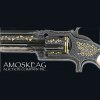
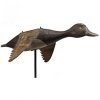





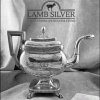

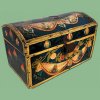

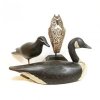






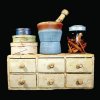






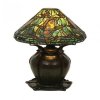

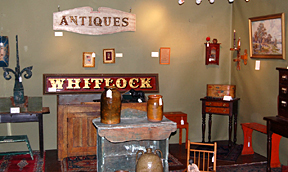
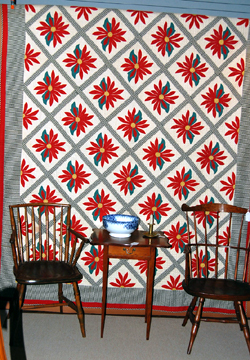
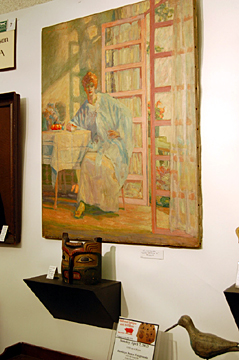
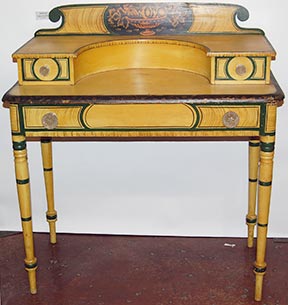
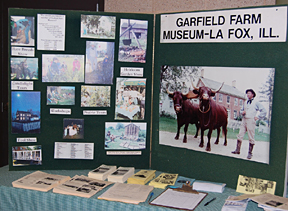
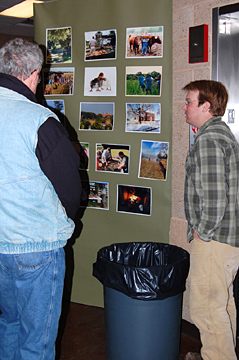
 Exhibitor and show cochair Donna Finegan of Palatine, Illinois, brought a selection of early dresses. Here she shows a circa 1870 printed cotton two-piece everyday dress with red china buttons and a handstitched lining, priced at $885. Note the peplum, considered a new look in clothing today!
Exhibitor and show cochair Donna Finegan of Palatine, Illinois, brought a selection of early dresses. Here she shows a circa 1870 printed cotton two-piece everyday dress with red china buttons and a handstitched lining, priced at $885. Note the peplum, considered a new look in clothing today!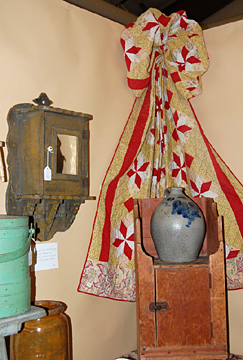 We cannot begin to figure how Ken Weitzel of The Rock Step Antiques, Spring Green, Wisconsin, displayed the $325 Wisconsin quilt so decoratively, but he told us, “I got the idea from older dealers years ago.” The $495 folk art cupboard (left) is in as-found condition and has traces of green paint over the original mustard yellow. The 1880’s bucket bench is topped by a $945 signed Milwaukee jug made in the 1850’s.
We cannot begin to figure how Ken Weitzel of The Rock Step Antiques, Spring Green, Wisconsin, displayed the $325 Wisconsin quilt so decoratively, but he told us, “I got the idea from older dealers years ago.” The $495 folk art cupboard (left) is in as-found condition and has traces of green paint over the original mustard yellow. The 1880’s bucket bench is topped by a $945 signed Milwaukee jug made in the 1850’s.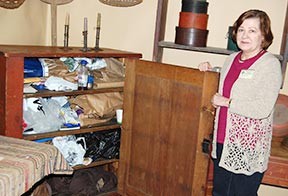 Here’s the secret no show dealer wants the public to know. Cupboards and drawers are prime places to stash stuff. Mary Anne Erenberger of Amana, Iowa, was a great sport to let us picture storage in progress. The 1850’s Amish cupboard, possibly from northwestern Pennsylvania, is all original with red paint ($2700). It may have been a linen cupboard, as the shelves had no marks from the bottoms of jars when she found it.
Here’s the secret no show dealer wants the public to know. Cupboards and drawers are prime places to stash stuff. Mary Anne Erenberger of Amana, Iowa, was a great sport to let us picture storage in progress. The 1850’s Amish cupboard, possibly from northwestern Pennsylvania, is all original with red paint ($2700). It may have been a linen cupboard, as the shelves had no marks from the bottoms of jars when she found it.







